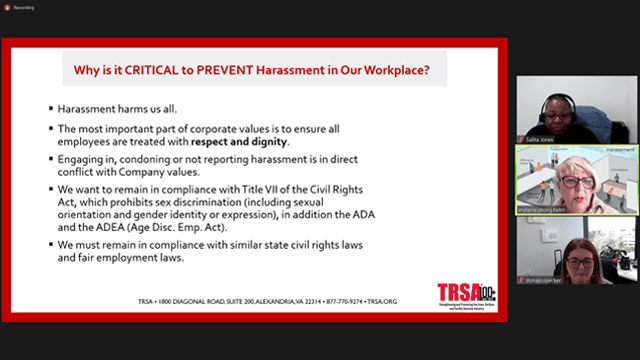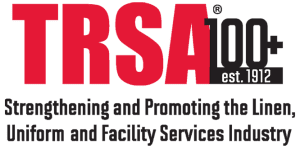‘Zero Tolerance’: Best Weapon Against Workplace Harassment

If you treat your employees with dignity and respect, then a “zero tolerance” stance on harassment or discriminatory behavior at work follows naturally, said Melanie Shong Helm, an HR expert who addressed the second session of the three-part “Safe Space Series” on Oct. 4 sponsored by TRSA’s Diversity, Equity & Inclusion (DEI) Committee.
This latest installment of the committee’s interactive series was titled “Workplace Harassment Workshop.” The program drew nearly 40 online attendees for an overview of employee harassment and discrimination rules and how to ensure ongoing compliance with federal, state and local mandates in these areas.
Helm, who serves as director of human resources for Crown Health Care Services, a regional chain based in Pensacola, FL, discussed in her 90-minute presentation that ensuring compliance with personal conduct rules is critical – not only to avoid legal liability but to root out demoralizing and harmful behavior by some employees against others as quickly as possible whenever they occur. “If you don’t have a policy, get one,” she said, speaking of workplace conduct rules designed to prevent harassment, particularly stemming from personal characteristics, such as race, religion, sex, age, disability and sexual orientation. These rules are based on various federal laws, such as Title VII of the Civil Rights Act of 1964, that are aimed at ensuring fair treatment for all employees. “We have to be very intentional in how we treat people,” Helm said, noting that sometimes an employee can offend one or more colleagues unintentionally.
Typically, workplace harassment takes various forms, including offensive language, online words or images, or physical gestures such as a male or female employee leering or whistling at a co-worker. Making negative comments about a person’s religion or sexual orientation could also put a company in legal jeopardy, unless prompt action is taken to discipline the offending employee, up to and including dismissal. When such behavior occurs, it must be reported and investigated, said Helm. “If you see it, you must say something,” Helm said.
A few other guidelines that Helm emphasized included the need to:
- Ask employees who are implicated in harassment or discrimination incidents either to read the company’s policy on these issues aloud in the presence of a manager, or to have the manager read the policy aloud to them. This prevents the employee from claiming ignorance of the policy itself.
- Never allow “quid pro quo” arrangements among employees. For example, if a manager promises an employee they will receive a promotion or a raise if they agree to have sex with the manager. These types of arrangements could pose a major liability for the company.
- Bar retaliation of any kind against any employee who brings a compliant of harassment or discrimination to a supervisor. Employers must weigh each case on its merits. However, denying promotions or reassigning an employee to a less-appealing job because they brought a harassment or discrimination compliant to a supervisor’s attention could place a company in legal jeopardy.
While every workplace has a certain amount of joking around, such as wisecracks about a given employee’s favorite football team, where does an employer draw the line between friendly banter and harassment or discriminatory conduct? Helm advised employers to apply a “reasonable person” standard in such cases. “Offensive is in the eye of the beholder of what a reasonable person would expect,” she said. Employers should weigh jokes or other comments or actions, such as snapping a towel against the leg of another employee, in light of this standard. “If a reasonable person would find it offensive, it could be an assault,” she said. Discretion is advised. Helm recalled a case where an employee made a formal complaint about not receiving a cupcake from another employee. The employee who brought them used their own money and gave them to her team to celebrate an accomplishment achieved for their client. The person who complained was not a part of the team and therefore did not share in the celebration. This didn’t qualify as offensive behavior, so the complaint was thrown out and no further actions were taken. In more serious cases, offensive conduct at work can not only put a company in legal jeopardy, it also can serve as the “silent killer of employee morale,” she said.
For those companies that may not have a human resources department, Helm suggested asking their corporate counsel to advise them on refining or designing anti-harassment/discrimination policies to ensure compliance with all applicable statutes, including state and local rules.
In all cases where an employee comes to a supervisor with a compliant of harassment/discrimination, a manager should interview the complainant. Helm recommended that the manager take notes during the discussion, but not record the person’s remarks electronically. The interviewer should prepare questions in advance, based on what they already know about the situation. Employees can comment anonymously, but the company should caution them that it will respect – but can’t necessarily guarantee – an individual’s confidentiality, depending on the nature of the offense and the facts surrounding it, she said.
Helm seasoned her presentation with anecdotes from her personal experience in the work world, which includes HR leadership posts at Huntington Ingalls Industries, Mobile Oil and Coca Cola. In one case, a female employee accused a 28-year male employee of sexual harassment. After interviewing both parties, a mutual agreement was reached that allowed the male employee to keep his job, but he was moved to another area to reduce the amount of contact with the female employee. The male employee was warned that if the behavior continued, he faced dismissal. Later, due to the increased production load, the male employee was moved back to his original department only after management consulted with the female employee. Unfortunately, the harassment did recur and the male employee was immediately fired. However, by treating both sides with dignity and respect, and by engaging the parties in an open process of adjudication, Helm made the best of a difficult situation. “When that person was fired, he thanked me,” she said. “He felt he was treated fairly.”
The DEI Committee’s series of interactive forums began on Aug. 30 with a session titled “How to Deal with Workplace Burnout.” Click here to listen to this forum. A third session, titled, “How to Cope with Stressful Times,” is slated for Nov. 3. The DEI Committee and Strategic In/Sight Partners are offering a special incentive for attendees who participate in all three sessions: a free book, The Awesome Human Project: Break Free from Burnout, Stress Less and Thrive More in Work and Life, by Nataly Kogan. This recently published volume lays out an inspiring program for mastering workplace stress and leading a happier, more successful life. Click here to learn more.
